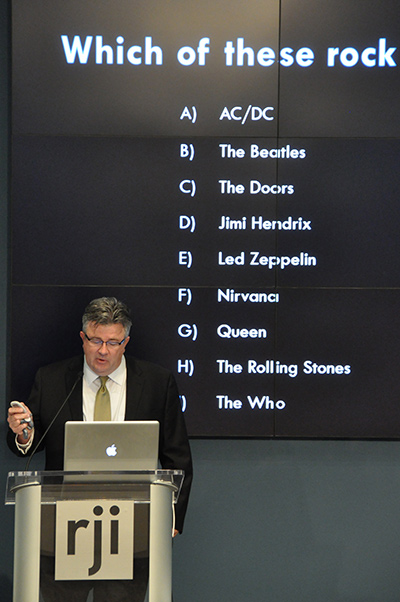
That’s engagement: Forum participants plot course to preserve born-digital news content

The opportunity to advance the preservation of born-digital news is real. That’s my takeaway from the Dodging the Memory Hole: Saving Born-digital News Content forum, which was held Nov. 10-11 at the Donald W. Reynolds Journalism Institute at the Missouri School of Journalism.
One of the primary objectives of the event was to help build and solidify a network to preserve born-digital news content: journalism that was created on a computer or captured on a sensor. Throughout the forum, people were engaged in conversation. Whether they were one-on-one, in small groups or in the plenary sessions, people were obviously energized by talking with each other in a time and space devoted to preservation of born-digital news. At one point in a plenary session, I invited participants to share their thoughts with the person next to them. The room erupted in excited conversation and it took sustained efforts on my part to regain the group’s attention. That’s engagement!
The 78 conference participants self-identified themselves as the following: memory institution professionals (28 percent), news librarians (6 percent), information technologists (12 percent), journalists (17 percent), journalism academics (11 percent), lawyers (2 percent) and others (25 percent). This mix of occupations was the result of nearly a year of sustained efforts to bring a variety of key stakeholders into this focused conversation.
We were especially fortunate to have Marc Wilson, CEO of TownNews.com, join the discussion. TownNews.com is a content management system (CMS) provider for more than 1,600 newspapers in the U.S. and Canada. As the only representative of a CMS platform in the room, Marc took a lot of kidding about his status as what he called an “accidental archivist.” Over the past 25 years, Marc’s love of journalism led him to take pains to preserve the digital content for his customers. Of late, he has even found ways to reduce storage costs for his customers in order to encourage them to store content instead of deleting it.
Marc is a trailblazer in this area and I’m excited to see what sort of collaborative projects may come out of his willingness to explore the new territory that born-digital news preservation represents today. In addition to more CMS companies, I would like to see leadership from the information service industry, news aggregators, big tech, philanthropies and online-only news organizations.
Born-digital news preservation is a multifaceted problem in which progress in any one area is often dependent on movement in another. Memory institutions need to work with journalists and others to gain access to content; media enterprises and CMS vendors could benefit from digital preservation experts in archives and libraries who have years of experience to share. All parties need to continue the conversations that were started at Dodging the Memory Hole outside the structure of a moderated event. In addition, many participants formed teams to begin addressing three key action areas we identified at the forum: awareness, standards and practices, and legal framework. I’ll be sharing more about how others can help advance those efforts in a future post.
From where I sit, the network of people and institutions that want to preserve born-digital news content is growing and getting stronger. We have the opportunity to work together to break new ground. Let’s do it!
Comments